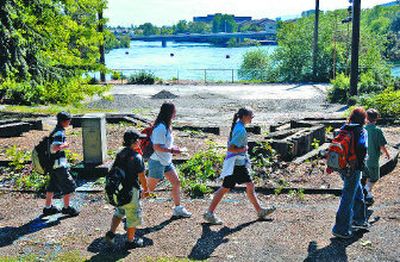Getting a new look

Nestled along the eastern edge of Riverfront Park, hidden behind earthen berms and rows of trees, lies a rarely used and largely forgotten part of the park – at least until now.
Spokane parks officials announced earlier this month that they will reclaim 2.5 acres of Riverfront Park that has seen little use since Expo ‘74, when it was known as the Boeing International Amphitheatre.
Light standards, a concrete stage area, electric utility vault, brick seating areas and small planters made from railroad ties are still there.
The amphitheater has served one important function over the years: It has been the launching site for fireworks displays.
But parks officials want to renovate the area as a venue for performances and private catered events. The area looks eastward up the Spokane River toward Division Street. A concrete dam with spillways flanks the waterway to the northeast. A sculptured sundial, set to daylight time, marks the location of the former Australian exhibit a short distance to the north.
“This kind of fell into polite ruin and became kind of a storage area,” said Taylor Bressler, park projects manager.
Last week, work began on the removal of trees that have been growing there since the fairgrounds were converted to Riverfront Park in 1975. Three large red maples were taken out. Rows of Scotch pines, white firs, more red maples, at least one ginkgo and other trees will be taken out in coming weeks.
“It’s a spectacular view of the river and with the overgrowth, for years it’s just been hidden,” said Nancy Goodspeed, parks spokeswoman.
Earthen berms built as part of the conversion of the Expo grounds to Riverfront Park will be graded down and the earth spread into the amphitheater bowl to create a better contour for seating, Bressler said.
When Riverfront Park was created, its trees were salvaged from Expo and intentionally planted close together to give the park a tree-lined look early on. Today, the oaks, sycamores, maples, pines and other specimens are crowded, Bressler said.
Removal of trees at the Boeing amphitheater will solve that problem, he said. Replacement trees will be planted with proper spacing, he said.
Bressler said performances were attempted in the amphitheater after Expo, but the venue never gained much interest. “It really served its purpose during the fair, but afterward it never caught on,” he said.
Goodspeed said the project will open sight lines, increasing safety for park users who might walk into the area.
In addition, Bressler said he is recommending installation of a heated restroom in a second phase of the project, possibly in 2008. The second phase would also include lighting and accessibility for people with disabilities. A shelter will be added either as a permanent or removable structure.
One idea is to open up the area for catered events put on by nearby hotels or the Convention Center, he said.
The first phase – removing trees and recontouring the land – is expected to cost at least $100,000 and will be paid for with money left from a park improvement bond issue in 1999. That work should be completed by November, Goodspeed said.
The second phase could cost $300,000. Financing has not been decided, although the parks department normally uses a portion of its annual budget for capital projects.
The improvements were approved by the Park Board four years ago. Goodspeed said one reason for delay was Avista’s rebuilding its dam adjacent to the amphitheater.
Bressler said, “We talked about it for too long. Let’s get it done.”